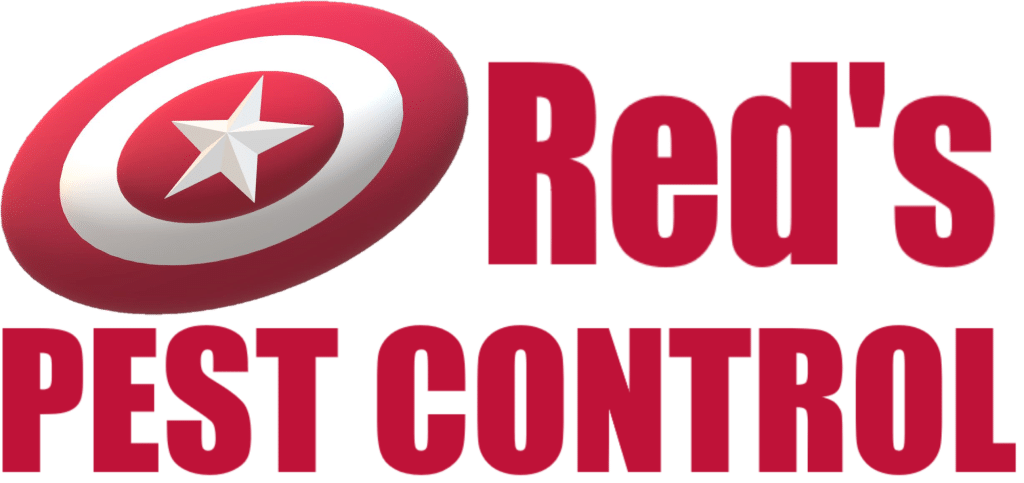Pick a pest to learn more
Table of Contents
Ants
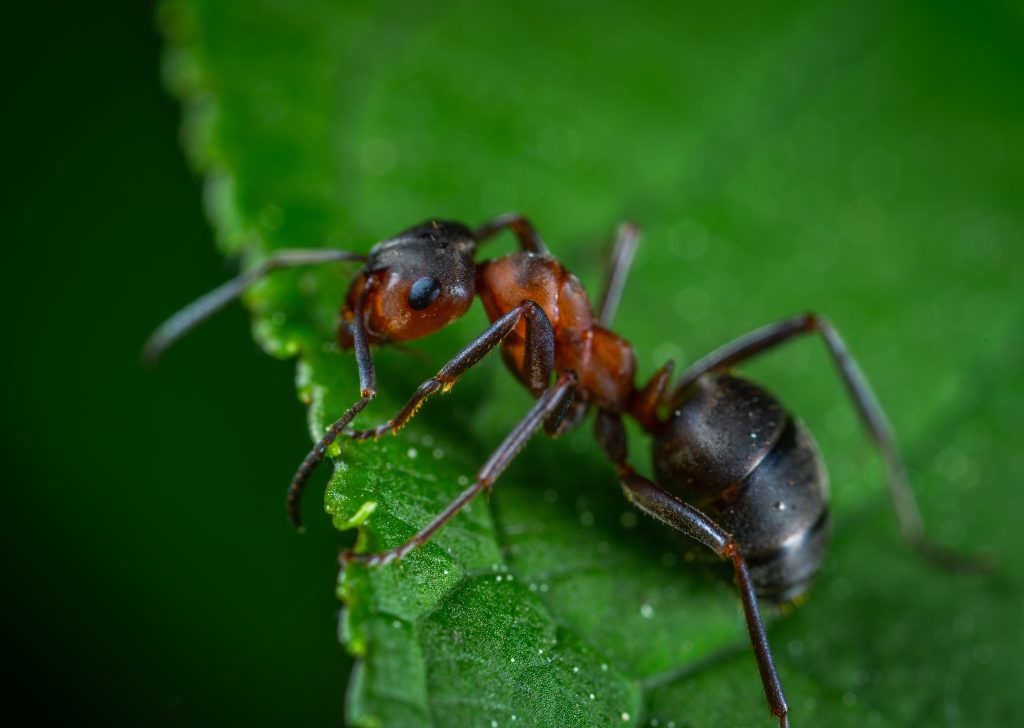
Information on Ants
There are many types of ants here in Texas! The more terrifying and widespread ant we deal with, the Red Imported Fire Ant, got it’s own page here.
The rest are briefly explained below.
Odorous House Ants form fairly robust colonies when they manage to get indoors. They got their name due to a tangy, tropical, musty smell they emit. They are small, black (or dark brown), and usually have more foraging ants than trailing ants. They aren’t highly prolific in this area, but we get enough of them that it’s worth talking about. Baiting is usually the best option for evicting them from your home and we have a special bait that has proven effective.
Argentine Ants, as the name implies, originated from South America. They look almost exactly like Odorous House Ants, the only differences needing magnification to see. The easiest simplest way to tell the difference is to check by the smell. Argentine ants are one of the few ants in the world that make “super colonies”. Fortunately, they haven’t quite taken a foot hold in this area.
Crazy Ants are so named due to their rapid and slightly erratic movement. Their populations are increasing in the area, and they’re proving adept at living indoors or outdoors. They tend to move their colonies closer to where they can find food and warmth. Like Argentine Ants, they’re also renown for making “super colonies” and I imagine as time goes on, we’ll likely see more and more of them.
Pharaoh Ants are some of the smallest ants we have around here. They appear to be a light, pale, tan color. They’re usually attracted to protein rich, sweet foods. They’re quite picky unfortunately, making baiting them out a delicate process. While these ants may happily live outside, they tend to go unnoticed out there. It’s when they decide to move indoors that they become a problem. These ants represent a significant problem in this area.
Little Black Ants are indeed actually correctly called Little Black Ants. I have no idea who thought of that name, but I commend the originality. As the name implies, these ants are very small, and very dark colored. They typically favor deploying trails of workers to food sources, and usually keep their colonies near a water source of some type. It’s very common to find them in the kitchen more than any other room. These ants, like the Pharaoh ants, represent a large number of our ant calls.
Carpenter ants are often very difficult to control because their feeding and trailing habits are different than most other types of ants. This large dark colored ant is not at all common in the urban areas of San Antonio, but they appear from time to time in the country and nearby. They do not eat wood, like termites do, but they tunnel into wood to make their homes. The nest must be located if you expect to get control, but the nest could be in a hollow door, an attic joist or even an old stump outside of the house.
Acrobat ants are easily confused with carpenter ants. They’re somewhat similar in size and color to the untrained eye. The 2 easiest ways to tell the difference is to look at the Acrobat’s heart shaped abdomen, and if there’s a variety of sizes in the trails of ants you’re looking at. If you’re holding a single ant in your hand, ID might be a little tougher. You’ll want to look for differences in the antenna and the pedicels. It’s also noteworthy that Acrobat ants are often active in the daytime, whereas Carpenter ants are more active at night.
Bed Bugs

Information on Bed Bugs
Twenty years ago, most pest control companies were not even training their technicians in how to control bedbugs; a normal, smaller outfit like ours would only get one or two jobs a year. Now it is not unusual to get that many calls a week! The National Centers for Disease Control (CDC) attributes the increase in bedbugs to the influx of immigrants from around the world and to the fact that bedbugs have become largely immune to most insecticides.
If you are suffering from bug bites, please give us a call! We have biting bug experts that can usually identify the bug just over the phone. While you should not rule out bedbugs, if you cannot see what is biting, you would be well advised to check for bird mites, fleas, or mosquitoes also. All of these blood suckers have bites that can be very annoying; they blemish the skin, and they often get infected. Bedbugs have not been shown to be disease vectors, but they leave stains on bedding, furniture, walls and flooring. Those stains are one of the evidences that you might have bedbugs. Other evidence would be droppings, molting castoffs, eggs, and the bugs themselves (if you can find them).
Bedbugs are not easy to bring under control, they are often resistant to common pesticides. Red’s Pest Control recommends many different approaches in order to completely eradicate these persistent parasites. The first requirement is to be very thorough in monitoring and inspecting to determine the extent of the infestation and to find out if there are any other biting insects involved. The next thing is to isolate the beds with mattress and box spring encasements like those from www.protectabed.com. This will keep bedbugs and mites from lurking in the mattress ticking. A good inspection tool is a hair dryer set on high. Heat up the joints and seams in the frame of the bed; this will cause the bugs to come hustling out to get away from the heat. Collect a few for positive identification before you plan on any treatments.
If you are doing your own pest control, you can use a series of treatments that are directed toward the places that bedbugs like to hang out between feedings; this includes bed frames, dressers, tables, chairs, molding, window frames, and any other place near the bed that may have become a bedbug hideout.
Bedbugs are very tough and resilient and have developed a resistance to most pesticide treatments. To overcome the problem of chemical resistance we utilize a selection of flushing agents, insect growth regulators (IGRs), and a variety of materials that we use during two or even three visits in order to completely eliminate the bedbugs.
Give us a call for more information and help! We will gladly advise and help.
Boxelder Bugs
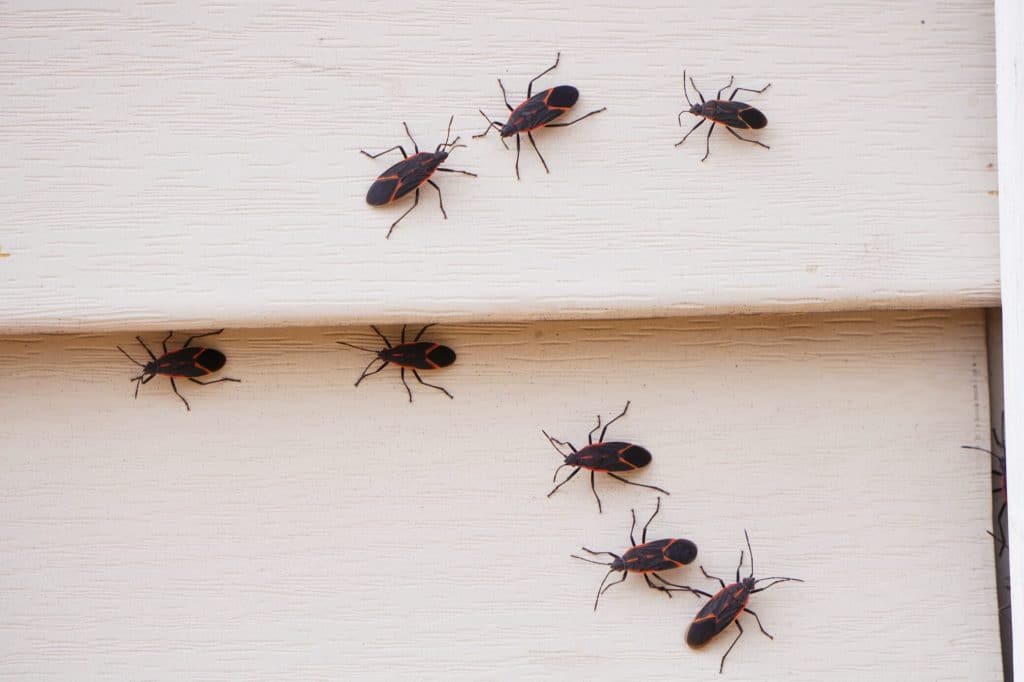
Information on Boxelder Bugs
Boxelder bugs are a common insect pest found in Texas and throughout North America. These bugs are small, measuring between 0.5 and 1 inch in length, and are black with red or orange markings on their backs. They have a distinctive shape, with a flattened, oval body and a pair of wings that overlap on their backs.
Boxelder bugs are primarily herbivores and feed on the leaves, seeds, and bark of box elder trees, as well as other members of the maple family. While they are not harmful to humans or pets, they can be a nuisance when they enter homes and buildings in search of warmth and shelter during the cooler months. You might notice them congregating on the Southern side of your home — where the sun usually warms up a little more.
Boxelder bugs typically enter buildings through cracks and crevices in the exterior walls or foundation. Once inside, they will congregate in large numbers in warm, sunny areas such as windowsills or around light fixtures. While they do not cause substantial damage to buildings or furnishings, their presence can be unsettling and their droppings can be unsightly. To prevent boxelder bug incursions, it’s important to seal any cracks or openings in the exterior of your home or building.
Boxelder Bugs are a source pest; what that means is to correctly treat them, you’ll need to find the source they’re coming from first. Simply spraying the adult bugs you’re seeing on the side of the house won’t resolve the problem in it’s entirety. If you have any box elder trees or other maple trees from your property or nearby, it could be the plants are dealing with an infestation of these bugs! You’ll need to contact a plant care company. If you do encounter a box elder bug infestation, contact us and we’ll gladly give you a referral.
Carpet Beetles
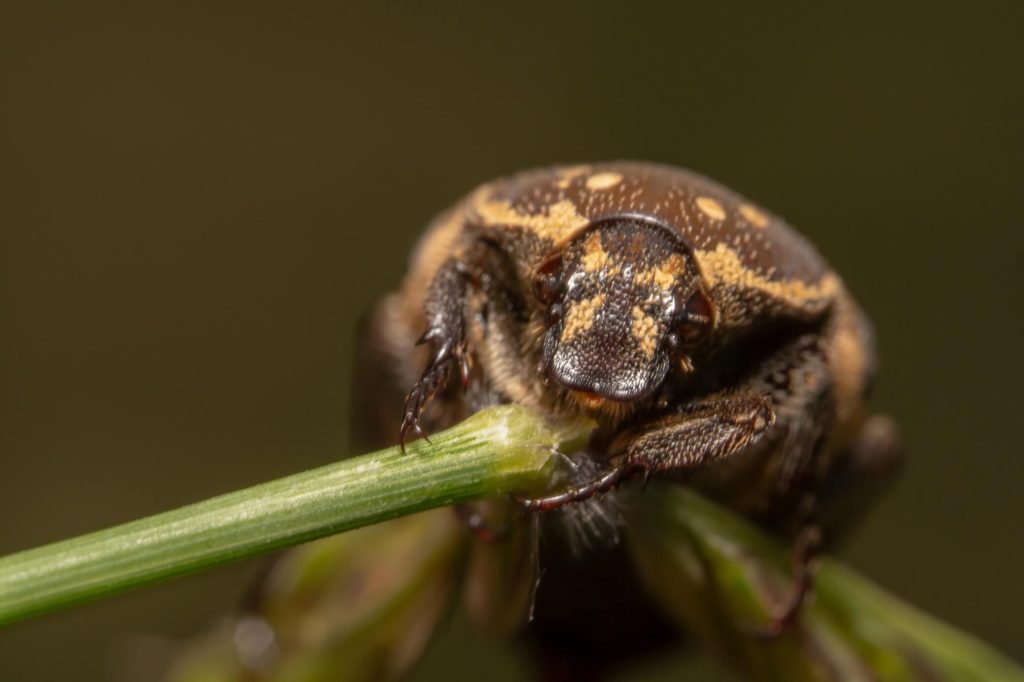
Information on Carpet Beetles
Carpet beetles are a common household pest that can cause damage to your carpets, upholstery, and clothing. These small insects are usually brown or black in color and measure about 1/8 to 1/4 inch long. Their larvae are roughly the same size, and have a distinctive round shape and are covered in tiny hairs that give them a fuzzy appearance.
You’ll typcially notice the adult bugs first, they tend to show up in the spring. The adult Carpet Beetle is short lived, and feeds on nectar or other sweet sugary foods. The carpet beetle larvae is the destructive member of this bug’s life cycle.
Carpet beetle larvae feed on a variety of natural fibers, mainly wool. They are attracted to pet hair, woolen fabrics, and down feather pillows or comforters. In addition to causing damage to your belongings, carpet beetle larvae can also trigger allergic reactions in some people.
The control for this bug is surprisingly simple. You only need to find and remove their source. Whatever the bug is infesting needs to be either treated or removed, which should effectively solve the entire problem.
The adult carpet beetles can be distracting in this search, keep in mind that they do NOT feed on the same food as their larvae! They are attracted to bright windows and lights, and colorful items or flowers in the nearby area. You’ll want to look in the room where the beetles show up, and every nearby room and closet. You’re after anything that is made with animal by-products.
You’ll know you’ve found the infestation when you find the damaged material. You’ll likely also see the larvae themselves, as well as chaff from their damage and pupal casings from their metamorphosis.
At this point, the hard work is done. You only need to treat or dispose of the infested items, and carefully monitor the area for the next few days. The adults carpet beetles should die out over the next 2 weeks. To insure no larvae survive, I recommend sanitizing the area they were found in!
If you have any questions or need anything else, feel free to contact us! While most of this is fairly simple enough to do on your own, it can seem daunting; we’re happy to help out and provide more details.
Centipedes
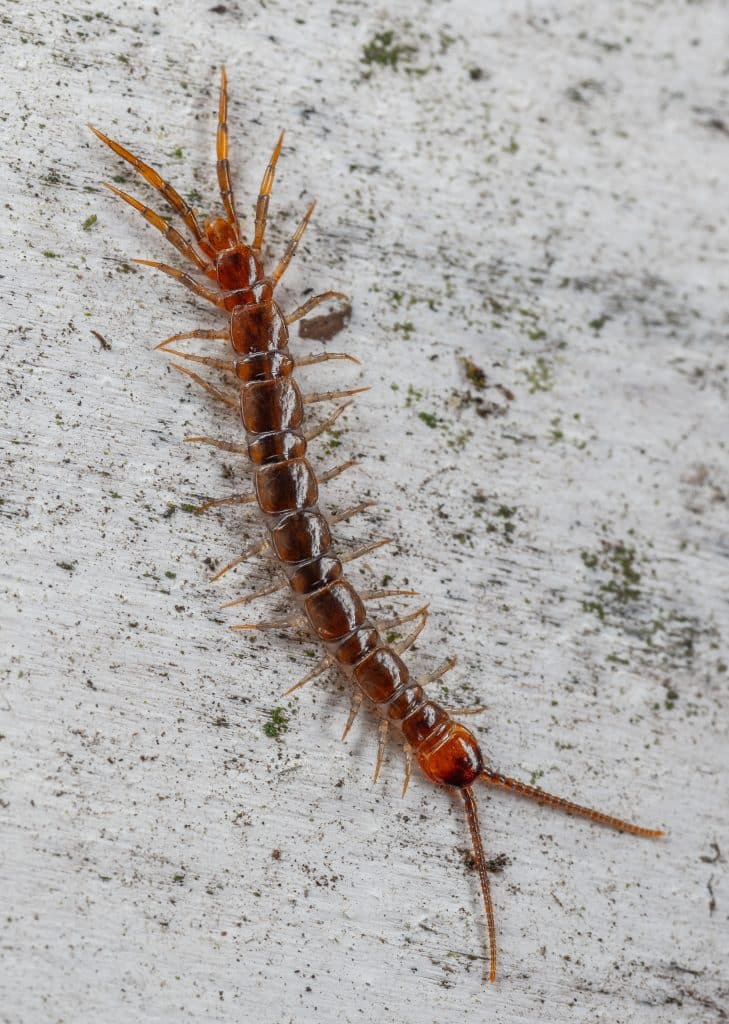
Information on Centipedes
Centipedes are arthropods that can be commonly found in homes and gardens. These long, segmented creatures can have anywhere from 15 to 177 pairs of legs, making them quite intimidating. In this area, it is rare to have them sting people. While they are not usually harmful to humans, they can still be quite a nuisance and are often considered pests. Here are some helpful tips for dealing with centipedes in your home.
The first step in dealing with centipedes is to identify where they are coming from. Centipedes are nocturnal creatures and tend to hide during the day. They are attracted to damp environments, so if you have any areas in your home that are prone to moisture, such as basements or bathrooms, these are likely places where centipedes may be living. Once you have identified these areas, you can take steps to make them less hospitable to centipedes.
One effective way to control centipedes is to reduce the amount of moisture in your home. This can be done by fixing leaky pipes or faucets, using a dehumidifier, and ensuring that there is proper ventilation in areas such as bathrooms and kitchens. By reducing the humidity in your home, you will make it less attractive to centipedes and other moisture-loving pests.
Another way to control centipedes is to seal up any cracks or gaps in your home’s foundation or walls. Centipedes can enter your home through tiny openings, so sealing up these gaps will make it much harder for them to get inside. This can be done using caulk or weatherstripping, and is a relatively simple and inexpensive way to keep centipedes out of your home.
While centipedes may be a nuisance, when outdoors they are generally not harmful to humans. However, if you are dealing with a centipede infestation, there are several steps you can take to get rid of them. By reducing the amount of moisture in your home, sealing up any cracks or gaps, and using traps or insecticides, you can effectively control centipedes and keep them out of your home. If you are unsure about how to deal with centipedes, give us a call! Red’s Pest Control would be happy to provide assistance.
There are several types of centipedes you can find in this area, in no particular order:
The House Centipede (Scutigera coleoptrata) is a common species of centipede found in many parts of North America, including Texas. These centipedes are easily recognized by their long, slender bodies, which can grow up to 1.5 inches in length. They are typically yellowish-grey in color and have long, spindly legs.
Texas house centipedes are nocturnal creatures and are often found in homes, where they feed on other insects such as spiders and roaches. While they may be a bit unnerving to some people, Texas house centipedes are not harmful to humans and are actually beneficial in controlling other pests in the home.
Despite their harmless nature, Texas house centipedes can still be a nuisance if they become too abundant in the home. They prefer dark, damp environments such as basements and bathrooms, so reducing moisture levels in these areas can help to discourage them. Additionally, sealing up any cracks or gaps in the home’s foundation or walls can help to keep them from entering the home in the first place.
The Chinese Red-headed centipede (Scolopendra subspinipes mutilans). A species of centipede that is native to many parts of Asia, including China, Japan, and the Philippines. This centipede can also be found here in Texas, where it has been introduced as an invasive species. It has a distinct red head and dark brown or black body with yellow legs. The body is segmented and covered with a hard exoskeleton that helps to protect the centipede from predators.
Despite its intimidating appearance, the Chinese Red-Headed Centipede is generally not harmful to humans. However, its bite can be quite painful and can cause swelling and redness. In rare cases, people who are allergic to the venom may experience more severe symptoms, such as difficulty breathing or a rapid heartbeat. Therefore, it is important to handle these centipedes with caution and avoid disturbing them if possible.
Texas Red-Headed Centipede (Scolopendra heros). Often confused with The Chinese red-headed centipede, this large and colorful centipede is also easily recognized by its bright red head and yellow legs. It can grow up to 8 inches in length and is found throughout Texas. Although its venom is not typically lethal to humans, its bite can be extremely painful and can cause swelling, redness, and other symptoms.
Banded Desert Centipede (Scolopendra polymorpha): This centipede is found in the southwestern United States, including Texas. It is typically around 4 inches in length and has distinctive banded markings on its body. Its venom is not considered dangerous to humans, but its bite can be quite painful.
Stone Centipede (Lithobius forficatus): This small and common centipede is found throughout North America, including Texas. It is typically brown or gray in color and has a segmented body with numerous legs. Its venom is not considered dangerous to humans.
Black-Legged Centipede (Scolopocryptops sexspinosus): This centipede is found in many parts of the United States, including Texas. It is typically around 1 inch in length and has a dark brown or black body with distinctive yellow legs. Its venom is not considered dangerous to humans.
Eastern Bark Centipede (Hemiscolopendra marginata): This centipede is found in the eastern United States, including Texas. It is typically around 3 inches in length and has a segmented body with numerous legs. Its venom is not considered dangerous to humans.
Cockroaches
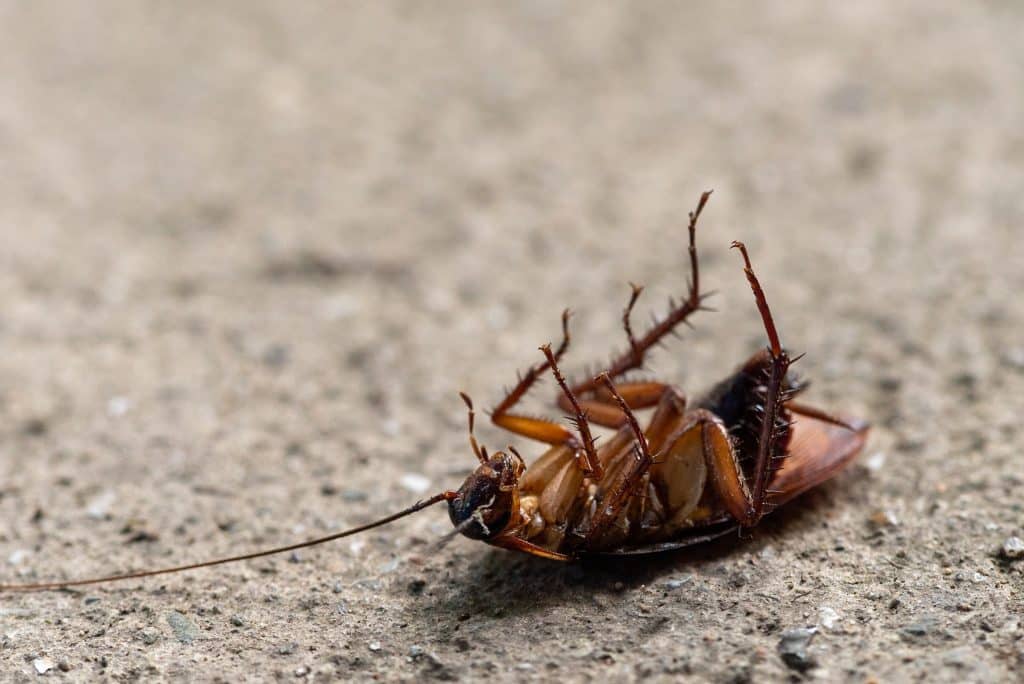
Information on Cockroaches
There’s 2 broad catagories of roaches here in Texas. A smaller type of roach usually about half an inch in size or smaller, and a larger type, usually about 1 to 2 inches in size.
The smaller kind, known as the “German Roach,” is bad news. These are the roaches that your mom probably warned you about when you were a child. “Keep a clean kitchen or you’ll get roaches!”
German Roaches are small, they’re typically about half an inch in size or smaller. They have 2 horizontal stripes going down their back, and in their adult stages have wings they rarely use. They’re not known for flight. They’re typically reclusive and nocturnal. If you have a German Roach problem, call Red’s Pest Control to set up a treatment plan and get them kicked out of the house.
The other category of roach we have around here goes by the very ‘scientific’ name of “Not German Roach.” These roaches include roaches like the Oriental Roach, the American Roach, the Red Racer Roach, and many others. We commonly nickname these bugs “tree roaches,” “waterbugs,” or “palmetto bugs.” At their adult stages, they’re known for being much larger than the German roaches, they’re typically around 1 to 2 inches in side. Some can grow to be even larger!
The good news is, they are usually rather benign, and are hardly anything like their cousins, the German Roaches. Controlling these waterbug roaches typically comes down to controlling their food sources. As the name implies, waterbugs are very dependent on water. One of the main reasons they get inside is because they’re looking for that resource.
If you’re only seeing the occasional larger roach indoors, it usually means there’s either an open door nearby, or some loose weather stripping. It’s highly recommended to keep the doors shut to keep these pesky invaders out. You may notice them after a weather event, such as when it rains, or when it gets hot or cold all the sudden.
If you’re seeing smaller roaches along with larger roaches, it’s possible you have an infestation of waterbugs inside or very near the home. It’s recommended to check that the sprinklers are functioning correctly, and there’s no standing water near the house. Double check your meter for any possible leaks inside, and look around where you’re seeing the roaches for signs of leaks or standing water. Feel free to give us a call for more advice and treatment plans!
Crickets

Information on Crickets
Crickets are a common insect pest found throughout Texas, particularly during the warm summer months. While crickets are quite idyllic for the camp grounds and may seem harmless with their chirping when outdoors, they can really be a noisy nuisance if they get inside! Here’s what you need to know about crickets in Texas and how to prevent infestations:
Crickets are easily recognized by their long antennae and distinctive chirping sounds. There are several species of crickets found in Texas, including the field cricket, the mole cricket, and the house cricket. These crickets vary in size and color, but all have a distinct body shape with long, slender legs and wings.
Crickets are attracted to warm, moist environments with plenty of vegetation. They can often be found in grassy areas, gardens, and wooded areas. They are also known to infest homes and buildings, particularly in areas with moisture or food sources. Crickets are omnivores and will eat a variety of plant and animal matter. If you’re dealing with an unprecedented rush of crickets, if might be due to a bright light that stays on overnight somewhere. Try leaving the porch or outdoor lights off and see if that makes a difference.
To prevent cricket infestations, it’s important to keep your home and yard clean and dry. Remove any piles of debris or wood from your yard, and keep your grass and landscaping well-maintained. Indoors, seal any cracks or gaps in your home’s foundation, doors, and windows to prevent crickets from entering. Additionally, consider using yellow bug lights outside, as they are less attractive to crickets and other insects.
If you have a cricket infestation in your home or yard, there are several treatment options available. Insecticides can be effective in killing adult crickets, but may not be as effective in controlling eggs or nymphs. Sticky traps can also be used to capture and remove crickets from your home.
Feel free to call us if you need any help with these little bugs!
Fleas

Information on Fleas
Fleas are a common pest problem in Texas, and they can be both annoying and difficult to control. These tiny insects have a four-stage life cycle: egg, larva, pupa, and adult. The adult flea prefers to live its entire life on a hairy host and can live up to two years with occasional blood meals. However, most only live for two to three months because they spend their energy laying hundreds of eggs.
Female fleas need a lot of blood to reproduce, and they typically insert their feeding tube under the skin of a host, inject a little anti-coagulant to keep the blood flowing, and then feed until they are dislodged. They pass blood through their bodies to provide a ready food source for larval fleas, as the preferred food source for fleas in the larval stage is adult flea droppings.
If you see what looks like salt when you brush your pet, those are flea eggs that produce the larvae that feed on the blood droppings. When the larva is ready to go through its change of life, it wraps itself in a silken blanket that is camouflaged with debris and attaches to the base of your carpet or a similar safe place. Fleas will remain in the pupa until the conditions are proper for feeding and reproduction, and then they emerge for a blood meal to continue the circle of life.
Under normal circumstances, over 90% of the fleas will be on the host animal at any given time. However, when fleas are allowed to breed freely on the pet and in the house and yard, their numbers can increase to infestation levels in just a few weeks! Most people do not realize they have a flea problem until it reaches the stage of major infestation with fleas seeking new hosts. When that happens, it is often necessary to treat the animal, the house, and the yard to get a reasonable level of control.
To prevent flea infestations, it’s important to maintain a regular exterior pest control service and keep your pets treated with the latest flea treatments. The best of the new tools are the treatments that are placed on the pets, which are much safer than the old “spray ‘em and slay ‘em” routines that once dominated flea treatments.
If you suspect you have a flea problem in your home, contact a professional pest control service like ours. We can advise you on the best flea control options for your specific situation and provide the necessary treatments to eliminate the problem.
In Texas, fleas can be a serious nuisance, but with proper prevention and treatment, you can keep these pesky insects under control and protect your home and pets from their irritating bites.
Flies
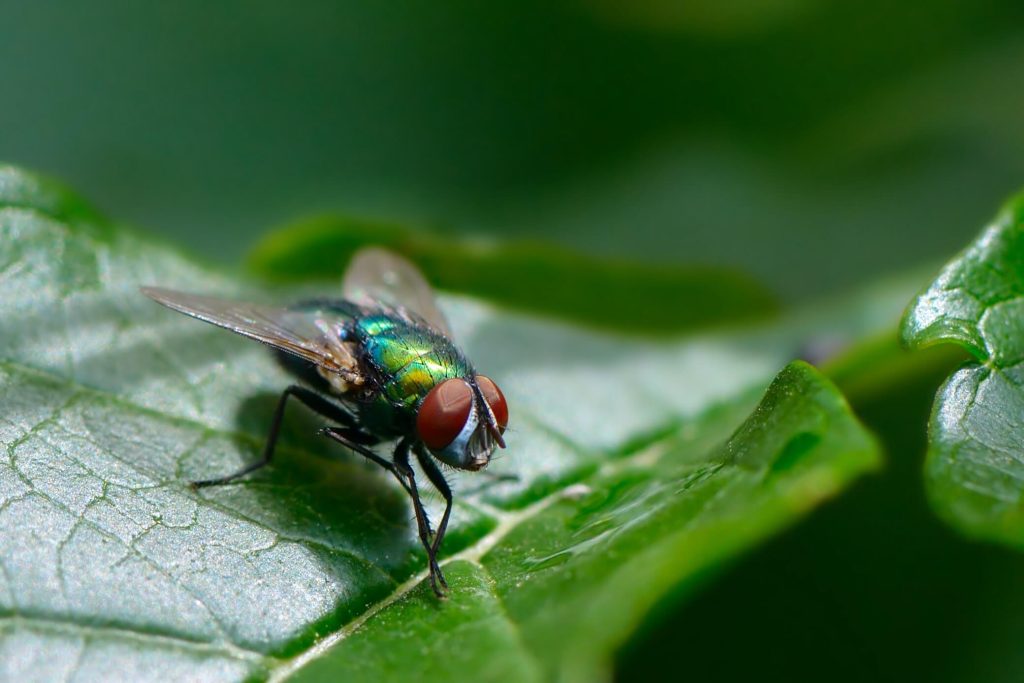
Information on Flies
Flies are a common household pest that can quickly become a major annoyance if left unchecked. Not only are they bothersome, but they are also known to be unsanitary and carry a variety of diseases and parasites. Some of the illnesses that they can transmit include typhoid, cholera, dysentery, and diarrhea. Flies have a four-stage life cycle, which includes the egg, larvae, pupae, and adult stages. While some species of flies can live for only one day, others can survive for several weeks with just a small amount of moist food.
Flies come in different shapes, sizes, and colors, and they are attracted to decaying organic matter. They are most active during warm weather and can be difficult to control once they have found a food or breeding source. The best way to control them is to screen them out of homes and eliminate their sources of food and breeding, such as uncovered trash cans, dog droppings, and other sources of organic matter. Fly traps and fly baits can be helpful but may also attract more flies than they control. Therefore, it is important to place the traps away from the area where you are trying to control the flies.
Overall, proper fly control involves identifying the source of the infestation and taking steps to eliminate it. Spraying for flies may kill a few, but it is often ineffective in the long term. By taking the time to locate the source and eliminate it, homeowners can effectively control the number of flies in and around their homes.
For an outdoor fly incursion:
When you’re dealing with flies outside the house, there’s a few good control methods.
Commercially available fly sprays are very invasive and are usually only marginally effective. The same goes for fly baits, I suspect those baits tend to attract more flies than they control anyhow!
The best methods of fly control normally involve screening them out of houses and cleaning up their food and breeding sources such as dog droppings, uncovered trash cans, and similar fly magnets. Flies are “source pests”, meaning that they tend to only show up if there’s a source of some type attracting them.
A fly trap can also work, the problem is that they typically attract many more bugs than they control. I recommend simply placing the trap away from the area where you’re trying to control flies; for an example, setting the fly light on the other side of the yard from the porch, to attract the flies AWAY from the porch.
Installing softer glowing yellow bulbs for the porches and exterior lighting can also help. Many flying pests show up at night because they’re attracted to bright lights. Don’t confuse the the soft glowing bug lights with the bright glowing bug light traps! One attracts flies, the other doesn’t.
For proper fly control, locating the source of the infestation is almost always the correct answer. There’s very few positive results from trying to spray for flies, beyond just killing a few of the ones you see flying around. Even if you exterminate every single fly buzzing around, in just 10-15 minutes after you’re done, more flies from off site will be right back at it. It is highly recommended to take the time and effort to locate where the flies are coming from, or what is attracting them.
When they show up indoors, I loosely organize flies into 3 general categories.
House Flies are small (1/4 inch) grey to black insects with a pair of wings. They hang around lights, windows and damp areas of the house and search for food that they can absorb with their sponge like mouthparts. A housefly’s method of eating makes it a potential disease vector because it can pick up germs from garbage, sewage and fecal matter and then regurgitate, defecate or simply transfer those organisms by leg or mouth to human and animal food.
Carrion Flies: If you suddenly find yourself dealing with a massive outbreak of larger than normal flies, you might have a more serious problem. Carrion Flies usually means that there is some rotting flesh nearby, often a dead rat in the attic or something equally disgusting. Carrion flies are normally larger than house flies and they have a green or blue metallic appearance. When they show up in a house, they normally fly to the window with the most light and make annoying buzzing sounds. If you see anywhere from a dozen to a hundred large flies at the same time indoors, it usually means that they just emerged from the pupae. They often enter the house through light fixtures in the ceiling, which means that you are likely to find something dead in the attic.
Contact us for a rat and mouse inspection so that we can keep that from happening again. Red’s Pest Control recommends that you do NOT use rat or mouse poison if the animal has access to the attic, walls or substructure of your house! See our rat and mouse page for more information.
Small Flies: The last type of fly and likely the most common one we get calls for would be Gnats or Fruit Flies. Technically, there’s MANY types of bugs in this catagory, but their behavior and control is largely the same. These pests are attracted to damp and moist areas, such as kitchen sinks, drains, and houseplants. These small flies feed on decaying organic matter and can also become a nuisance by flying around and landing on people and food. While they are not known to cause any serious harm, their presence can be annoying and unsanitary. I strongly recommend finding the source of this pest prior to even attempting to spray! These bugs have a strong tendency to return if their source isn’t cleaned or removed. Sometimes it’s as simple as throwing away an old moldy fruit on the counter or taking out the trash, and sometimes it requires cleaning out the sink drain or the floor under the fridge.
Sometimes some termites are mistaken for flies or for flying ants, but they are a very different type of insect with a different life cycle than flies. Please see our termite page.
Honeybees
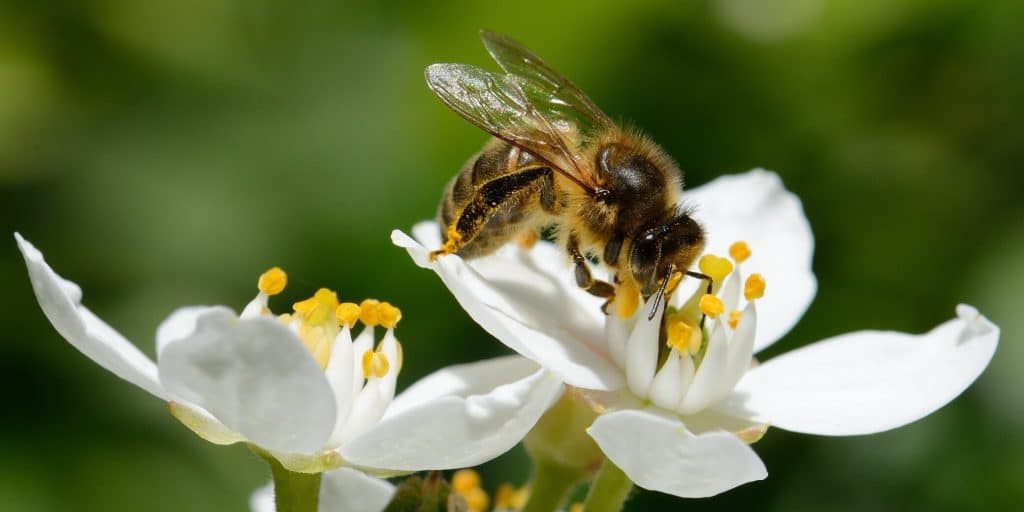
Information on Honeybees
Africanized bees, also known as “Killer Bees,” were initially brought to South America by researchers aiming to increase the productivity of European honeybees. However, African bees are incredibly aggressive in everything they do, including pollinating and protecting their hive. Unfortunately, the experiment went wrong when African bees escaped from the research facility in Brazil and began to breed, replacing the more docile European bees throughout South America and now in Texas.
Africanized bees are a hybrid strain that primarily comes from crossing African drones (males) with European honey bee queens. They appear in large numbers during the spring and sometimes in the summer, but then dramatically decrease as the weather cools since this region does not match their preferred biome. African and hybrid bee colonies tend to be close to the ground, so if you see bees coming and going from under a shed, in a valve box, or a water meter, be extremely careful since they can be very dangerous. Established hives are more likely to be aggressive than new swarms, and they have been known to attack people and pets hundreds of feet away from their hives. Bees can fly longer than you can hold your breath, so do not jump into the pool if you see bees nearby.
If you spot a honeybee swarm, which is a basketball-sized clump of bees surrounding a queen bee, and they are resting on a tree branch for a few hours, leave them alone as they usually do not pose a danger. However, a honeybee colony can grow quickly, with the queen laying between 800 and 1,500 eggs per day, resulting in a colony of over 60,000 bees in less than a year. If the hive has been present for more than a few months, it is crucial to remove the honey and hive materials to avoid damaging the structure. At Red’s Pest Control, we provide expert advice and honey and hive removal services. Contact us for more information on how we can help.
For more information about bees, beekeeping, and beekeeping supplies, visit https://beebuilt.com/pages/beekeeping-for-beginners.
Mosquitoes

Information on Mosquitoes
Mosquitoes are one of the most common pests in Texas, especially during the warm summer months. In addition to being irritating, they can also carry serious diseases such as West Nile virus and Zika virus. To keep your home and family safe, it’s important to take steps to prevent mosquito infestations.
Mosquitoes can be easily recognized by their long, thin bodies, six legs, and two wings. There are several species of mosquitoes found in Texas, including the Aedes mosquito, which is known to carry the Zika virus. They are most active during dawn and dusk hours but can bite at any time of day.
To prevent mosquito infestations, eliminate standing water around your home and property. This can include emptying containers that collect water, such as bird baths, flowerpots, and gutters. Also, keep your grass and landscaping well-maintained and consider using mosquito repellent when spending time outdoors. Our mosquito control services can allow you to enjoy your outdoor spaces.
Mosquitoes can enter homes through open windows or doors and can breed in any standing water inside the home, such as plant saucers or pet water dishes. To protect yourself from mosquito bites and the diseases they carry, wear long sleeves and pants, use mosquito repellent, and avoid outdoor activities during dawn and dusk hours.
Remember that mosquitoes can be a serious nuisance and health risk in Texas. By understanding how to identify and prevent mosquito infestations, you can protect yourself and your family from their irritating bites and the diseases they may carry. Call us if you have any questions or need any help dealing with mosquitoes around your home!
Pantry Pests
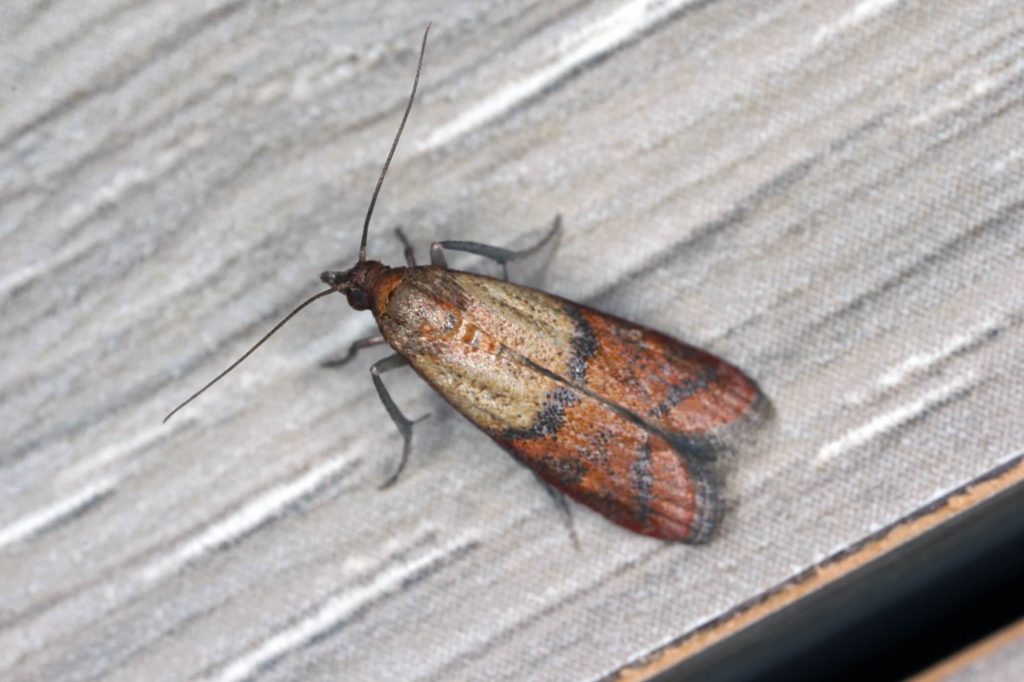
Information on Pantry Pests
One of the most frustrating pest problems for homeowners is dealing with pantry pests. These small insects can infest your pantry and kitchen, causing damage to your food and leaving behind a mess. Some of the most common pantry pests in Texas are Indian meal moths, beetles, and weevils. Here’s what you need to know about these pests and how to get rid of them.
Meal Moths: Meal moths, also known as Indian meal moths, are a common pantry pest found in Texas homes. These small, silver pale brown moths are about 3/8 inch long and have a distinctive pattern of a bronze tipped or copper-tipped wing. They lay their eggs on food items like flour, cereal, and other meal based products, and the larvae that hatch from these eggs feed on the food.
If you see the adult moths, or notice small, white larvae crawling around your pantry or find webbing in your food, you likely have a meal moth infestation. To get rid of meal moths, you’ll need to discard any infested food and thoroughly clean your pantry and kitchen. Read more below to go further into control and prevention techniques.
Beetles: There are many different types of beetles that can infest your pantry, including the confused flour beetle (Tribolium confusum), the red flour beetle (Tribolium castaneum), Drugstore beetles (Stegobium paniceum), and Cigarette beetles (Lasioderma serricorne). These small, oval-shaped insects can range in color from reddish-brown to black and can be anywhere from 1/16 to 1/8 inch in size.
Beetles can infest a wide range of food items, including flour, cereal, pasta, and pet food. They can also chew through cardboard and plastic packaging to get to the food inside. Signs of a beetle infestation include small holes in your food packaging, the presence of adult beetles, and larvae or eggs in your food.
Weevils: Weevils are a type of beetle that have a distinctive snout or elongated head. They can range in color from brown to black and are usually around 1/8 inch in size. Weevils can infest a wide range of food items, including flour, rice, and beans.
Just like the other pantry pests we have, these little bugs are usually indicative of a larger problem, hidden somewhere in the kitchen or nearby. You’ll need to find their source to correctly solve the infestation!
Control and prevention measures are the same for all of them:
Control: Clean out the cabinets and toss the contaminated food. Don’t worry about the adult bugs; they are just hanging around for social purposes and can be controlled with a vacuum cleaner. Find the contaminated food and get rid of it! Clean the shelves and drawers with any disinfectant cleaner and then…
Prevention: Keep your stored food in air tight containers. Do not place too much confidence in cereal boxes or the other containers that the food was in when it was purchased. You brought those bugs home from the store in the first place in packaged containers. What you need is to do is inspect and rotate your stored foods regularly. Be especially careful with things like cornmeal, bread crumbs, croutons, crackers, bran flakes, granola, and cold cereal. The boxes and bags that many grain products come in are not sufficient to keep bugs out.
You can use the freezer to control bugs in bird seed and other pet foods; it doesn’t bother the animals at all to have a little extra protein in their diet. I have seen birds picking out the moth larvae as special delicacies! Meal and flour moth larvae can chew their way into and out of cardboard boxes and thin polythene bags. Always keep stored materials in tight-fitting containers, preferably of glass, metal or tough plastic with a vapor tight seal. If an infestation should occur under these conditions (possibly introduced with newly purchased goods), it can be confined to a single jar or container and is easily eradicated by discarding the contents. Glass jars should have rubber seals, and metal or plastic containers should have tight-fitting lids. Tupperware has double seal lids on most of their containers, and some of the Rubbermaid products are good also. You should avoid the light plastic containers that do not lock in food vapors and do not rely on plastic bags for pantry pest control.
Red’s Pest Control does not recommend the use of pesticide sprays for pantry pest control. You cannot control the adult bugs without getting rid of the source of the infestation, and if that and the sanitation measures are taken care of there is no need for further action.
Red Imported Fire Ants

Information on Red Imported Fire Ants
The Red Imported Fire Ants (RIFA) are easily some of my least favorite bugs in the great state of Texas. They originally showed up in Alabama it’s suspected, about 100 years ago, and as they migrated west, they found San Antonio much to their liking. The reason that they are called “Fire Ants” is because their sting is very painful, and they are eager to sting! Each ant can sting multiple times and they attack in great numbers.
Fire Ants build mounds that can be as large as a foot and a half in diameter but the entries into the nest are in the soil all around the mound. When the nesting area is disturbed, the ants come boiling out, sometimes in great numbers, looking for the guilty culprit. Anyone nearby is in risk of being attacked and stung painfully many times. There can be as many as 250,000 in a single mound, but, most mounds hold less than 100,000 ants which is enough to make your yard unusable.
Fire Ant colonies are somewhat mobile, but the way they usually spread is by sending out reproductives to establish new hives. When the colony is new, it’s usually founded by a single queen, that lays a batch of eggs that take several days to hatch. Due to the lack of food and nutrients she’s able to provide to them, this first brood is rather small. Nonetheless, they work together to expand the tunnels and chambers of their new home, and forage for food. It typically takes around a month for the young queen and workers to establish a steady food supply, but then the colony will grow rapidly because the queen can produce 1500 eggs a day! From that point, and over the next 6 months, the colony will assert itself in it’s new territory, and the mound will grow.
Be sure to exercise extreme caution around a fire ant mound! Accidently stepping on or near the mound can cause the ants to attack in great numbers. As the first ones begin stinging, it triggers a reaction for the rest of the attackers to start stinging. If you’re not aware ants are crawling up your legs, when they start attacking, it can rapidly become overwhelming.
No yard should be “off limits” to the homeowners. Please call us for our One Shot Fire Ant Treatment, which gives results for 6 months! Let us help make your yard “off limits” to the fire ants!
Rodents
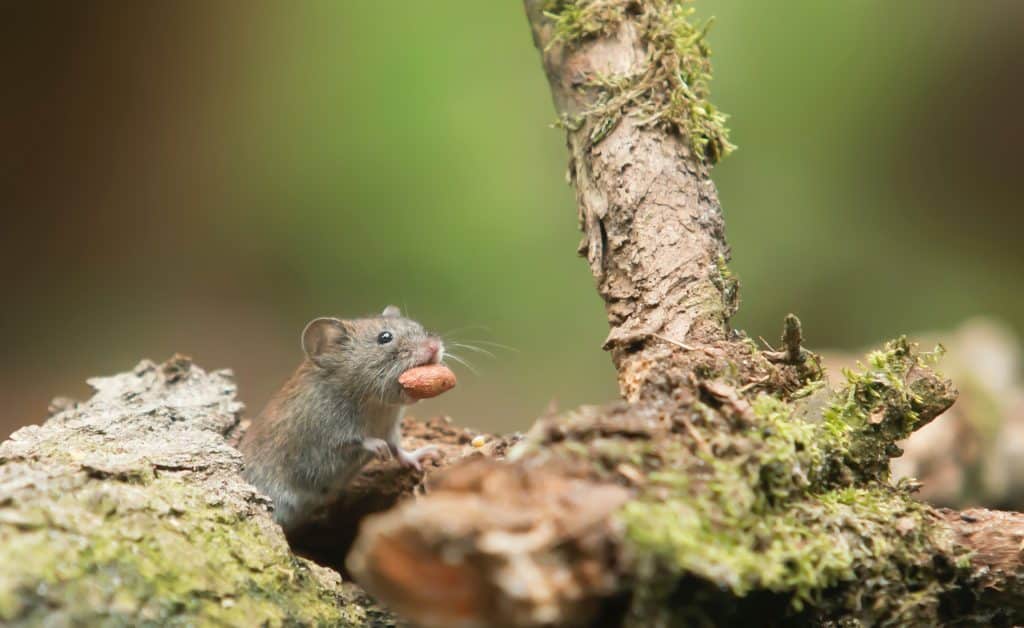
Information on Rodents
Rats and mice are two of the most common pests found in homes and businesses across the world. These rodents are known for their quick reproduction and adaptability, making them difficult to control. They can cause damage to property and spread diseases, posing a serious threat to human health. Rats and mice can enter buildings through small cracks and crevices, and once inside, they will make themselves at home, reproducing rapidly and leaving behind droppings and urine that can contaminate surfaces and food sources. These pests are particularly attracted to cluttered and dirty environments, making it important to keep homes and businesses clean and free of debris. Additionally, rodents can cause damage to electrical wiring and insulation, leading to potentially dangerous situations. It is important to address rodent infestations as soon as possible to prevent further damage and the spread of disease.
Roof Rats, also called tree rats or black rats, are the most numerous rats in this area; we often find them in our fruit and nut trees, in sheds, attics, sub areas, garages, and under the hoods of our parked cars. They can cause extensive damage to our homes, crops, and vehicles and they leave disgusting odors and contamination in their wake. Roof rats are very agile climbers and can run up and down stucco walls, cross cable lines and vines, and are also quite comfortable in sewer and storm drain lines as well. If you see a pile of broken snail shells under your BBQ or next to a condenser fan (or anywhere else for that matter), you probably have a roof rat nest nearby. Or it could even be the larger Norway rat!
Norway Rats are a bit bigger than roof rats with more snubbed out features. They’re also called brown rats or wharf rats. Norway rats are usually bolder than roof rats; they are sometimes active during the day, and they will walk right into an open garage or patio door, even in daylight hours. Quite often they dig burrows in the soil outdoors and they can tunnel into a substructure. Like the roof rat, they eat fruit, macadamia nuts, snails, insects, vegetables, pet food, bird seed, and almost anything else that they can find, including mice and other rats. To keep their teeth filed down, they’re known for chewing on a wide variety of inedible things like insulation on wires, plastic toys, brush handles, or furniture (among others); we get disabled vehicle calls on a regular basis.
Mice actually can cause more damage in a kitchen than rats do. They tend to taste everything they can get into and they are very good at getting into things. Mice are fast breeders that feed on almost anything and they can fit through a hole that is barely large enough to accommodate a pencil. Due to their size, it’s sometimes quite difficult to correctly exclude them from a structure.
Correctly resolving a rodent incursion always means first and foremost EXCLUDING them from the structure. DO NOT USE POISON if any rodents have access to a structure! I’ll bet you can figure out why. They rarely go outside to die, which leaves us with a nasty problem inside somewhere. If we’re lucky, it will be somewhere accessible, but it’s possible the varmint will end up expiring somewhere in the walls or hidden under the insulation in the attic.
Please feel free to call us for a complimentary inspection! We’ve had years of experience resolving rodent incursions and would be happy to assist.
If you are certain that you have no openings in the structure, the use of rat or mouse poison is a control option for outdoor areas. Please be very cautious about how you might use any kind of pesticide, especially rodenticide baits. Always read the entire label and follow those label instructions completely. Remember that rodenticides are attractive to non-targeted species and can cause great harm if they are used or placed improperly. Here at Red’s Pest Control, we use secured, locked bait stations that must be opened with a key for safety’s sake. Contact us if you would like us to do all of the above AND maintain the bait stations. Contact us for rodent control that includes all of the above AND we maintain the bait stations.
Scorpions
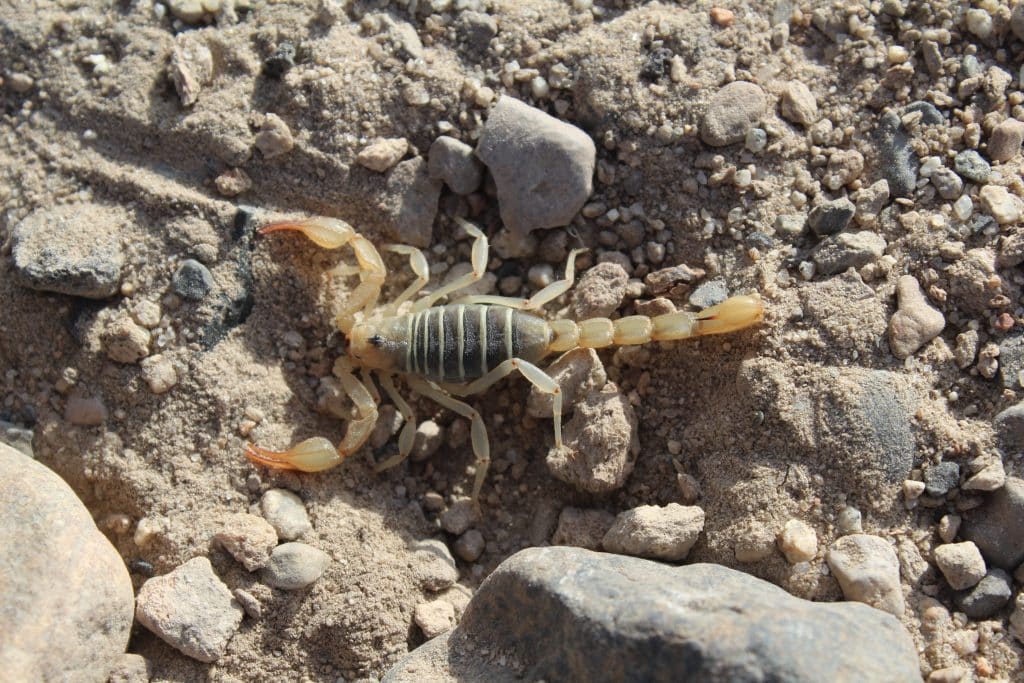
Information on Scorpions
Scorpions are a common pest in many parts of Texas, and it’s important to understand how to identify them and prevent infestations in your home.
In this area, the most common species are the striped bark scorpion, Texas bark scorpion, giant hairy scorpion, and devil scorpion. These scorpions vary in size, color, and venom potency, so it’s important to know how to identify them correctly.
When outdoors, scorpions in Texas are typically found in dry, arid regions such as the desert or rocky terrain. However, they can also be found in residential areas, particularly in homes with cluttered outdoor areas or with cracks or crevices that allow scorpions to enter. Scorpions are nocturnal and usually hide during the day, making it difficult to detect them until they are already inside your home.
To prevent scorpions from entering your home, it’s important to seal any cracks or gaps in doors, windows, and walls. Keep your home clutter-free and remove piles of debris or wood from your yard. Keep your outdoor lighting to a minimum, as scorpions are attracted to light sources at night.
If you find a scorpion in your home, it’s important to take caution and avoid direct contact. Use long-handled tools to capture or kill the scorpion, and wear gloves and protective clothing to avoid being stung. While most scorpion stings are not life-threatening, they can cause severe pain, swelling, and other symptoms. If your symptoms are severe, seek medical attention!
Overall, scorpions can be a nuisance and potential danger to your family in Texas, but with proper identification, prevention, and treatment, you can keep your home scorpion-free. Remember to stay vigilant. If you are dealing with scorpions or want to keep your home free of them, consider giving us a call.
Striped Bark Scorpion (Centruroides vittatus): This is the most common scorpion in Texas, including central Texas. It is typically yellowish-tan in color with two dark stripes on its back. Its venom is not considered dangerous to humans, although its sting can be quite painful.
Texas Bark Scorpion (Centruroides texanus): This scorpion is found in central and southern Texas. It is typically light brown or tan in color with a slender body and long tail. Its venom is considered mild to moderate in toxicity and can cause pain, swelling, and other symptoms.
Giant Hairy Scorpion (Hadrurus arizonensis): This scorpion is the largest in North America and can grow up to 6 inches in length. It is found in the western and central regions of Texas, including the Edwards Plateau and the Trans-Pecos region. Its venom is considered mild to moderate in toxicity and can cause pain, swelling, and other symptoms.
Devil Scorpion (Vaejovis spinigerus): This scorpion is found throughout much of Texas, including central Texas. It is typically brown or tan in color with a stocky body and short tail. Its venom is not considered dangerous to humans, although its sting can be quite painful.
Silverfish

Information on Silverfish
Silverfish are a common pest problem in many Texas homes. These reclusive insects have three filaments extending from the tail and are not often seen by homeowners because they only come out at night and are very good at getting out of sight quickly when the lights come on. However, if you see one stuck in a tub, sink, or even a glass or bowl in the cupboard, you might have a silverfish infestation.
Silverfish have what is called a “gradual” or “incomplete” metamorphosis, meaning that they develop into adults by stages rather than by pupation. Nymphs take years to mature into adult silverfish, and even as adults, they continue to molt and grow for as long as they live.
The primary food source for nymphs during the first few months of their lives is the droppings of adult silverfish. They do not come out into the open during the first two instars of development, making them extremely difficult to control with insecticidal sprays and dusts. Silverfish and their warmer cousins, firebrats, are especially long-lived for insects. In the tri-county area, they can live for as much as ten years and lay between fifty and a hundred eggs during a normal lifespan.
Silverfish love to feed on starch-rich materials, such as glue, some types of paper, linen, and silk. They also love cardboard boxes that you have stored in the garage. Interestingly, most homes that have a persistent silverfish problem also have a lot of unfinished wood surfaces. In fact, you will find more silverfish in the attic and basement than in the master bedroom. They have been known to damage clothing, but their main target is old books and pictures. Silverfish prefer humid environments, like bathrooms and sub areas. Some researchers claim that silverfish actually feed on mold in moist areas.
Sprays and insecticide powders are only marginally effective against adult silverfish, and none of the treatments that are currently available have a strong enough residual action to control the nymphs when they finally come out into the open. In most cases, the best way to control silverfish is to rely on bait. Dekko Silverfish Packs are a popular choice for homeowners and can be purchased online.
If you have an extensive silverfish infestation, please contact Red’s Pest Control for advice or treatments. While we cannot guarantee silverfish control, we can help to reduce the population dramatically in some homes. It may take as much as two years to control them in some circumstances, so please be patient with your pest control operator.
Spiders
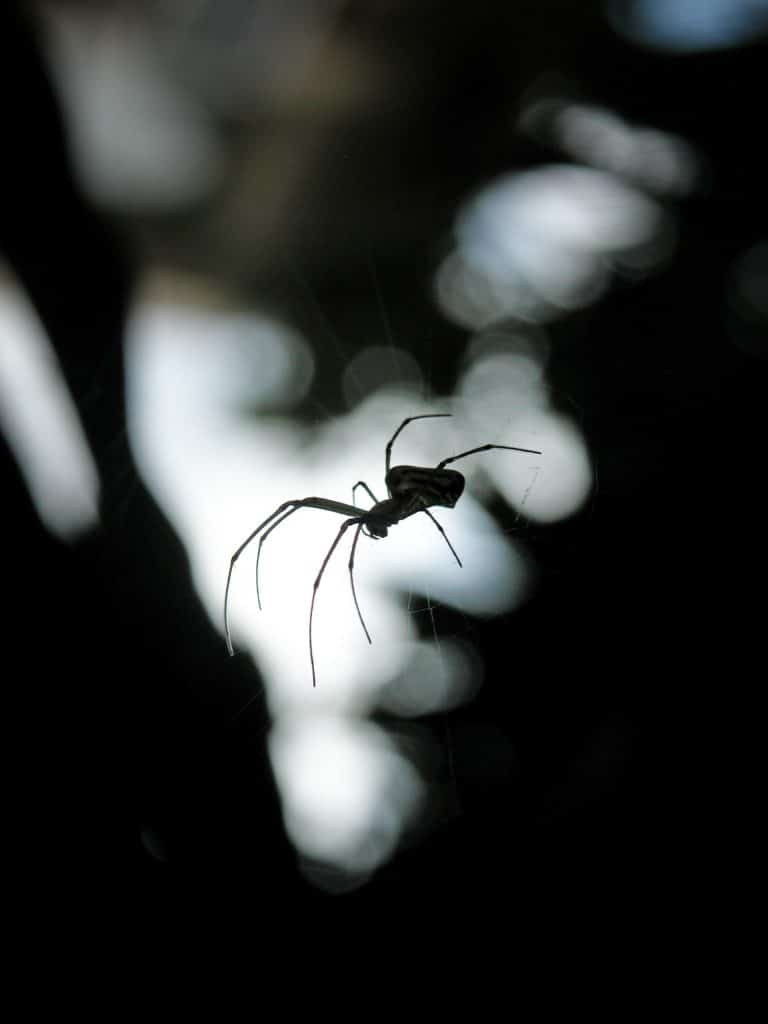
Information on Spiders
Spiders are common pests locally and they are actually beneficial in that they will make a meal of any insect that they can catch! They are often very difficult to control because they normally stay out of sight during the day and they try to avoid people. I usually find that a lot of spiders means that you have an abundance of spider food: bugs!
Nearly all spiders have fangs and venom but very few of them are dangerous to people. There are a dozen varieties of poisonous spiders in this area that can bite people, but they are eager to avoid contact with us and very seldom bite unless they are forced to do so by direct physical contact. Spider bites are actually quite rare, they occur much less frequently than you might think. The myth that spiders bite people at night is fairly well debunked by this article.
Despite how benign they might be, spiders can be a real nuisance with their unsightly webs and their threatening demeanor. Please read the following information about our local spiders and call us if you have any questions.
In general, there are two broad categories of spiders: web spinners and hunters.
Hunting Spiders usually scurry around at night, seeking a bug to jump on and eat. That is how they earned the name “ambush predators”. Some of these arachnids can weave webs, but typically do not use them to capture their prey. They often have several eyes, which come in handy for seeing both prey and other predators — as their preferred method of hunting means they’re often on the move. Jumping Spiders are hunters that are small to very small, some of them less than the size of one of the letters on this page, and many of them are very colorful. Wolf spiders are larger and hairier spiders. They are known for their distinctive eye arrangement, with two large eyes in the center of their face. With any type of hunting spider, they are usually not dangerous to people, but if you see a lot of them you might want to give us a call.
Web Spinning Spiders include tangled web spiders, orb weaver spiders, and funnel web spiders. As opposed to their mobile cousins, these spiders wait in place for food to come to them. They’re notorious for building their webs in places with gentle airflow (like the corner of a building) or in places where there is water. Web spinners use their spinnerets to create bug traps and to make nests or egg sacs that they spin for their offspring. Their webs can be tunnels, trap doors, nets, tents, sacs, and intricate patterned orbs. Some of the webs are sticky, and others can be tough enough to hold surprisingly large bugs. Orb Weaving Spiders are quite beneficial in that they catch lots of flying bugs every night! As long as they are not on a pathway, it’s not a bad idea to just leave them where they are.
Spiders come indoors to get something to eat and to escape inclement weather, the same as we do. It is not at all uncommon to find spiders indoors right after rainfall or during a cold spell, but the main thing that they are after is other arthropods (bugs). Keeping them out of the house is best done by keeping the screen doors shut and making certain that there are no gaps around your doors and windows. You should also try to keep any clutter and nesting sites to a minimum. The most effective control method is to cut back on their food supply by controlling bugs outdoors. Red’s Pest Control can help you with that.
If you find webs indoors, with no spiders, that’s unfortunately quite common and annoying! The spiders that wove those webs are likely already gone, but the ugly looking decoration they left is there in plain sight. A good way to tell if it’s an abandoned web is if it is dusty. Web spinning spiders try to maintain their webs, as it’s their best chance at a meal. An old dusty cobweb doesn’t need a treatment, just sweep it down. Web sweeping indoors is best done with a broom, if you would like to hire us, we take down most exterior webs that are connected to the house with each service visit.
Squirrels
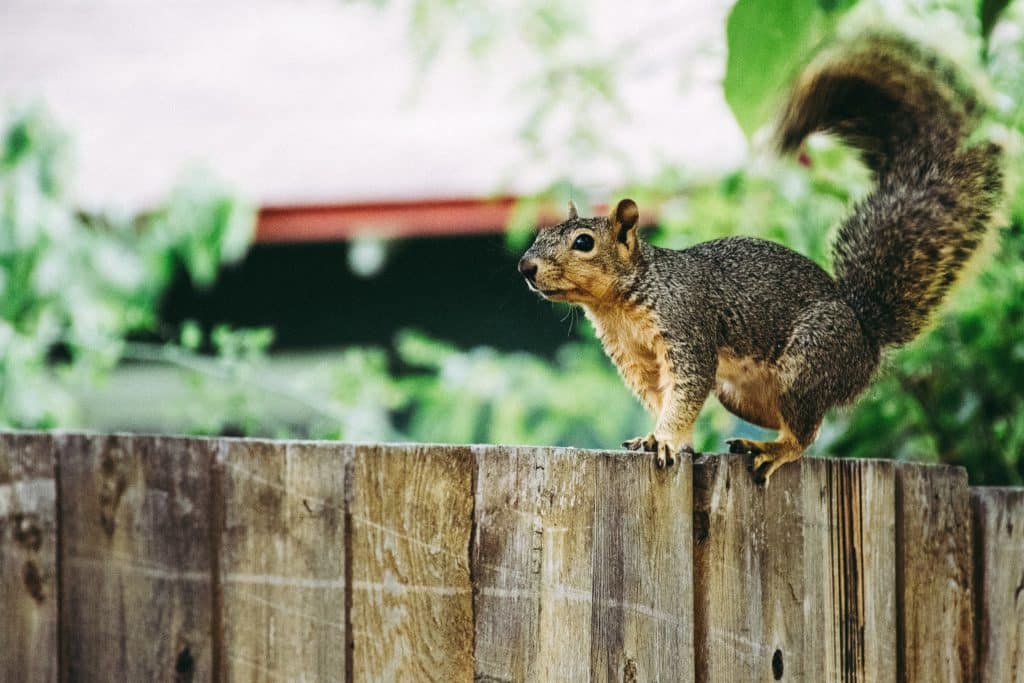
Information on Squirrels
Squirrels are a common sight in Texas, with several species found throughout the state. While they may seem cute and harmless, squirrels can cause serious damage to homes and property, and can even carry dangerous diseases. Here’s what you need to know about squirrels in Texas and how to prevent infestations:
Squirrels are small to medium-sized rodents with bushy tails, sharp claws, and sharp teeth. There are several species of squirrels found in Texas, including the Eastern gray squirrel and the fox squirrel. These squirrels vary in size and color, but all have a distinctive body shape and feeding habits.
Squirrels are primarily found in wooded areas and parks, but can also be found in suburban and urban areas. They build their nests, called “dreys,” in trees, and will also use attics, crawl spaces, and other enclosed areas in homes and buildings as nesting sites. Squirrels are omnivores and will feed on a variety of foods, including nuts, seeds, fruit, and insects.
Squirrels can cause significant damage to homes and property, particularly if they enter buildings. They can chew through electrical wires, insulation, and wood, causing costly repairs. Additionally, their droppings and urine can create unsanitary conditions and can spread dangerous diseases such as leptospirosis and salmonella.
To prevent squirrel infestations, it’s important to seal any openings in the exterior of your home or building, such as holes in the roof or foundation. Additionally, keep your landscaping well-maintained and remove any tree limbs or branches that are close to your home or building. Squirrels may seem harmless, they can cause significant damage and pose health risks if left unchecked. It’s important to take steps to prevent and control squirrel infestations in and around your home to avoid these issues.
Please call us if you want any help inspecting your home for squirrel access, or need any further advice on preventing them from getting indoors.
Termites
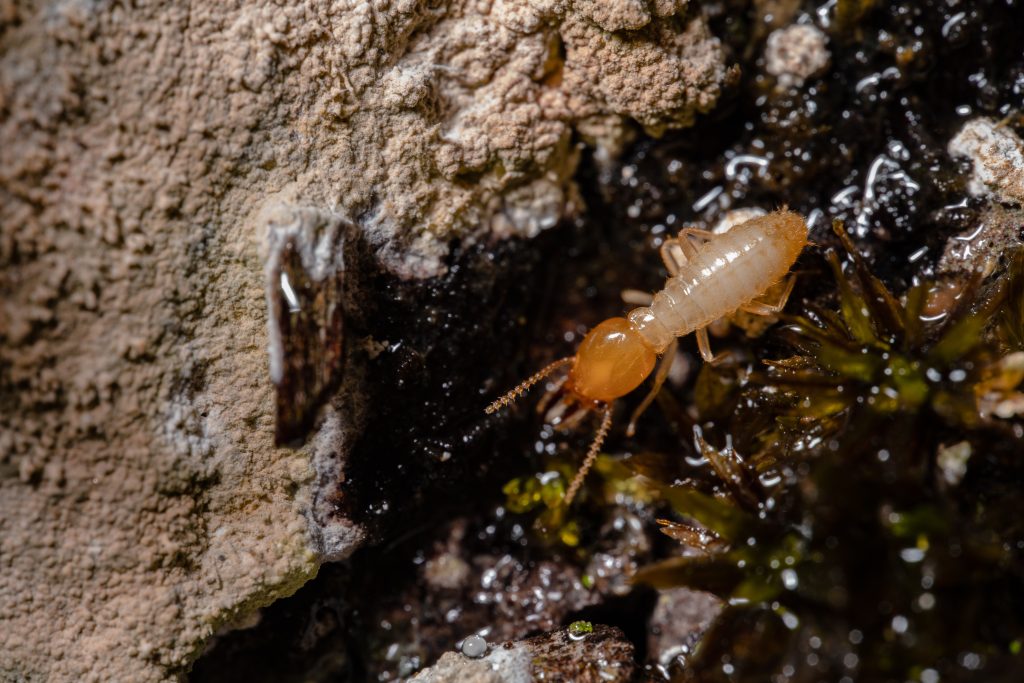
Information on Termites
Two types of termites are quite common in this area: Subterranean termites, and Drywood termites.
Red’s Pest Control does not offer termite treatments or inspections, but if you contact us we can refer you to a reliable, affordable termite inspector here locally that can give you more specific advice and appropriate treatments. Read on if you would like to know more about your voracious house guests!
Drywood termites are a not a very common problem for homeowners in Texas. These small, cigar-shaped insects are often mistaken for ants, but their lack of waist is a telltale sign of their true identity. Termite infestations are usually discovered when swarmers emerge after a rain, with their uniform wings extending well beyond their bodies. While these termites are often dark-colored with a distinctive orange head, they are difficult to detect as they mostly live within wood beams and structures.
Drywood Termites live entirely within the wood that they consume and never make contact with the soil. As a result, they are challenging to control and can cause significant damage to your home. The colorless, grub-like workers build galleries in the wood beams of your home, where they can thrive without exposing themselves to the open air. Each colony has soldier termites to protect them from invading ants. The soldiers have large heads with powerful mandibles and are slightly larger than the workers.
Many termite control companies in Texas require tent fumigations for Drywood termite control, although local treatments are less expensive and more effective if the wood to be treated is exposed or accessible. There are some excellent new materials available for local treatments when called for, but some companies are reluctant to recommend anything but a tent for various reasons. It’s essential to deal with a pest control company that is flexible in treatments and has extensive experience with local applications.
Both Drywood and Subterranean termites develop from the egg by gradual metamorphosis. They progress through six or seven stages called “instars” until they reach their adult form. Pre-adult termites are called nymphs, and they are involved in eating wood also.
Subterranean Termites are the more common termite we deal with in this area. They live in the soil in huge colonies and will establish smaller satellite colonies when they find a nice stump or a house to feed on. They establish mud tubes to move in while they feed on wood and sometimes use those tubes to gain access to a house.
Anytime there is earth-to-wood contact, you are inviting termites to dinner. Subterranean termites are associated with soil and moisture, so you will often find fungus damage to wood that is infested with them. To control soil-dwelling termites, you will have to treat the soil where they come from. Typically, this means placing a termiticide barrier between the sub-colony and the house, but some companies use a more expensive and invasive program of systematic termite baiting. Properly placed and serviced termite bait stations that are inserted in the soil can provide both control and valuable monitoring of termite activity.
Contact us if you would like a referral to a great termite inspector who will advise you as to the most effective and economical solution for your home.
Wasps & Hornets
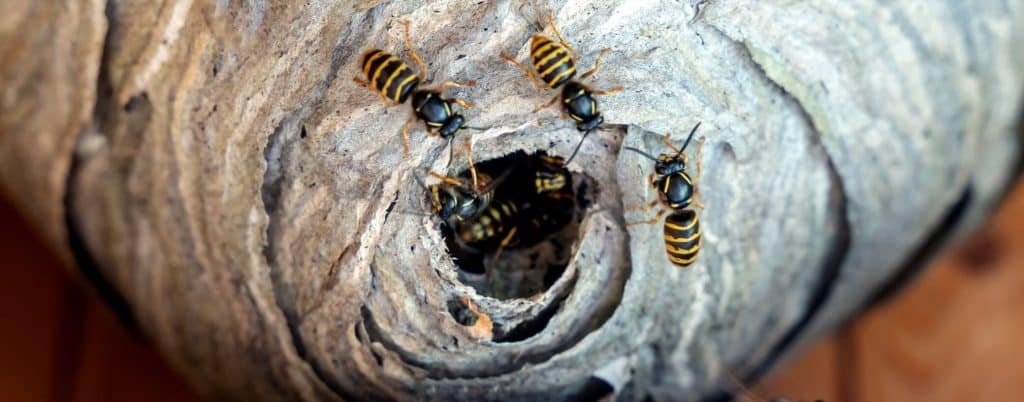
Information on Wasps & Hornets
When it comes to dealing with stinging insects like wasps, yellow jackets, and hornets, it’s important to know the differences between them and the best ways to control them. Here’s a guide to some common types of stinging insects in your area and what you can do to manage them.
Paper Wasps, also known as umbrella wasps, are named after their umbrella-shaped nests that hang from roofs. They come in various colors and sizes, including red, yellow, and black. While not particularly aggressive, they will sting if provoked, so it’s best to avoid handling or disturbing their nests. If you need to control a paper wasp nest, wait until after dark and use a commercial wasp spray (taking care to avoid drift) and then knock down the nest the following day. At Red’s Pest Control, we offer wasp control free of charge to our regular customers.
Mud Dauber Wasps are common in the area and are considered beneficial since they help control nesting spiders. The female wasps build small mud tubes on walls under porch overhangs to house paralyzed spiders, which will serve as food for their larvae. Mud daubers are not aggressive, and you can easily remove their nests with a garden hose. You could also sweep or scrape their nests down, but keep in mind the mud can leave traces and be difficult to remove. You don’t want to accidently scrape the paint on your home.
Bumblebees are not as common as they used to be due to the Varoa mite and competition with honeybees for pollinating. They are unlikely to build large nests and generally will not attack unless provoked. If you can, it’s best to leave them alone and they will usually move on after a few weeks. If they become a problem, contact a professional for assistance.
Yellow Jackets are ground-dwelling wasps that can be dangerous, especially to children and pets. They are very aggressive when defending their nests and can sting multiple times. If you need to control a yellow jacket nest, use dusts, aerosols, or liquid sprays, making sure to penetrate and destroy the underground nest to prevent the colony from repopulating. Commercial baits are usually not effective, so it’s best to contact a professional for assistance.
Baldfaced Hornets are actually a type of yellowjacket, although they are larger and have distinct black and white markings on their body. They are about 0.5 to 0.75 inches long. Baldfaced Hornets typically build their nests in trees, shrubs, or on buildings, and the nests can be quite large, up to 28 inches in diameter and containing up to 700 workers. They are known for their aggressive behavior when defending their nests, and can sting multiple times, causing pain and swelling. It’s important to avoid disturbing their nests or approaching them too closely.
By knowing the differences between stinging insects and the best methods for controlling them, you can keep your family and pets safe from painful stings. If you need help managing a stinging insect problem, contact a professional pest control service like Red’s Pest Control for assistance.

